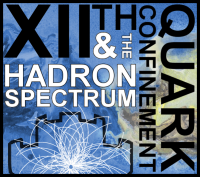Speaker
Description
Based on the new fit of hadron yield ratios within the multicomponent hadron resonance gas model we have found several remarkable irregularities at chemical freeze-out. In particular, 121 hadron multiplicity ratios measured in the nucleus-nucleus collisions at AGS, SPS and RHIC energies were successfully described within the new formulation of HRGM with $\chi^2/dof \simeq 63.978/65 \simeq 0.98$.
A dramatic jump in the center of mass collision energy dependence of pressure, energy density and baryonic charge density in the narrow range between 4.3 and 4.9 GeV is found. These irregularities are also accompanied by a sudden increase of the particle decays at chemical freeze-out which is seen at this collision energy range.
We argue that a strong correlation which we observe between the previously found irregularities and an enhancement of strangeness production can serve as the quark-gluon plasma formation signature. Thus, we conclude that a dramatic change in the system properties seen in the narrow collision energy range $\sqrt{s_{NN}} = 4.3-4.9 $ GeV opens entirely new possibilities for experimental studies of quark-gluon plasma properties at NICA JINR and FAIR GSI accelerators.
